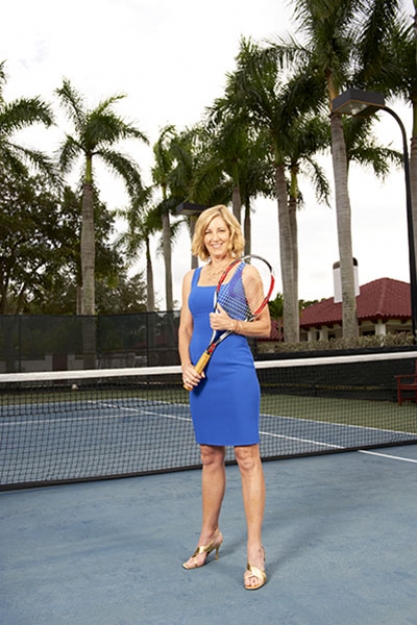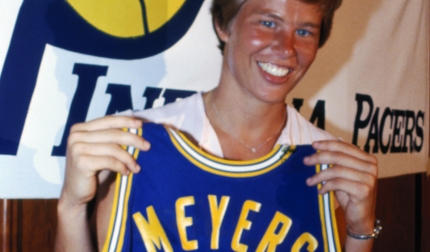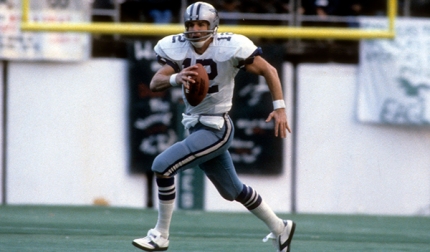Did you ever dream about doing anything else besides being a tennis player?
There was a time when I was in second grade—I was maybe eight years old—and I was working on a paper at school. I had this romantic notion about being a social worker, going to another country and helping families, giving to the less fortunate. After second grade, when I got a little older—12, 13, 14 years old, I was competing for and winning national championships in tennis. At that point, I felt like tennis was going to be the path for me.
When you look back, it must be special to have had your dad as a coach and to spend that much time with him at such an early age.
I would never have been in tennis if it wasn’t for my dad. He was an amateur on the circuit and a successful player in his own right. When he would be coaching, all the kids in the family would go to the tennis facility in Holiday Park after school. He wanted us all to be there after school with him because he didn’t want us to have idle time. He brought us over to keep an eye on us.
You played in your first US Open when you were 16. Prior to that, was there anyone who had done that before who you could look to for experience, or were you in completely unchartered waters?
I think I was the first one. Evonne Goolagong was young. Bjorn Borg. But I think they were more like 17 or 18 years old. I think I was the youngest. When I was 15, I beat the number one player in the world, Margaret Court. Up until then, no one had done anything like that, so I guess I paved the way. After that, Steffie Graf, Monica Seles and Jennifer Capriati made big splashes at 15. It’s much more common now.
You made it to the semifinals in that tournament. I imagine the other pros weren’t too happy losing to a 16-year-old amateur player. Were the other players hard on you?
At 15, I couldn’t relate to women in their middle or late 20s (laughs). I was more into my boyfriend. I didn’t want to miss homecoming! I was still young emotionally, and my heart was still back at school. I liked the social aspect of being a teenager. Not that I went out very much. I really didn’t. But when I was 17, I was on the cover of Newsweek, and some of the top women’s players got their noses out of joint. They were like, “We do all the work and she gets all the publicity!” They would definitely cheer each other on when they played against me. They weren’t friendly to me at all; let’s be blunt. Afterwards, they laughed about it, but at that time, they saw me as a young whippersnapper who was taking all the press, while they were doing the work to make the tour successful. It wasn’t until a few years later, when I started doing those appearances and talking to sponsors and working to help the tour, that I became accepted.
What was it like to have had that kind of experience on a national stage and then go back to high school class the next week?
It was so fake. In 10th grade, I was a wallflower. I was the one observing everything. I wasn’t the popular one. I wasn’t the beautiful one. I was watching it unfold, in awe of the popular girls. Then I made the semis at the US Open. All of a sudden, the whole school is waiting for me at the airport. The band is out there playing. The football players who wouldn’t look at me, now they’re looking at me. Fortunately, I was able to keep my feet on the ground and see it for what it really was. It wasn’t genuine. It really was the first taste of what fame was going to be like.
The following year you made it to the finals of the French Open and Wimbledon. In hindsight, you say, my goodness that’s amazing that someone so young did this. But as you were going through it, was it difficult for you to get that far in a major and not break through?
Not at all. My first French Open, I played when I was 17, I was beating Margaret Court in the finals 5-3 in third set, and I let it slip through my fingers. I wasn’t disappointed at all at that time. Emotionally, I felt very happy to be there and to be playing at that high level. At 16, 17, I wasn’t in any rush. I don’t remember feeling frustrated or that I didn’t belong here. I felt like it was going to happen when I was ready for it to happen.
The women’s professional tennis tour at the time was very fragile. Do you look back with pride on what you and some of the other players were able to do?
I would never have wanted to come up at any other time in tennis. Having Billie Jean King as the leader and my mentor, we really had an impact on the policies of the game. We were very active, and Billie Jean mentored me and other players to be the next leaders. Consequently, I became the WTA president for nine years to sell the sport, to sell women’s tennis, to do the press conferences, the appearances, the sponsor meetings, to try to engage people to watch us and support us. Players don’t have to do anything now. They can just show up and play. When you have to work harder to establish something, I think there’s more meaning and depth to it. To come up and learn from the best how to carry the baton, I can’t even imagine a better time for anyone to come along.
Being so famous as a teenager, were you able to enjoy the spotlight or would you have preferred not to have it on you?
It was a nice spotlight. It wasn’t like it is now with technology watching every move you make. It wasn’t like people were camping on my doorstep. It was a respectful sort of attention. I would have Arthur Ashe come talk to me. Rod Laver. People would ask me for my autograph as a teenager. It was fine. The level of attention is nowhere what it is today. It wasn’t threatening to me. When I got divorced, I think that was the first time I thought to myself, ‘This isn’t worth it! The price of fame is not worth it!” For the most part, it was very respectful. It wasn’t overwhelming.
Your rivalry with Martina Navratilova is one of the greatest in any sport. How does a rivalry like that drive you as a player?
I think it kept me in the game longer. It definitely kept me from getting bored. Look at Serena. Once in a while she might have a three-set match with a Victoria Azarenka, but she’s so good. She doesn’t have that natural rival to push her. Martina forced me to improve my athletic ability. I think I improved her mental toughness. When we played, you could feel the excitement of the fans. I think we brought a lot of people who may not have been watching the sport to participate in the rivalry. The bottom line was that it made us push each other to improve and find a way to beat each other. Consequently, it lengthened both of our careers.
With all that you’ve accomplished, is there one achievement that you are most proud of?
I’m proud of a lot of things (laughs). I don’t really talk about the stats stuff that much. I guess if there’s one thing I’m most proud of, its’ that I won over 90 percent of my matches. It was that consistency throughout my career. For 18 years, I was ranked in the top four. I never dropped to 13 or anything like that. I won 125 consecutive matches on clay. It was that consistency over a long period of time that I’m proud of.
That’s a long time. Just staying away from serious injuries is amazing. Did you ever feel burned out?
The first time I took three months off was when I was 24. I had been on tour for seven years. I was feeling a little burned out on competing. I had just got married, so I took a little sabbatical. But I think there were two major factors. First, there wasn’t the depth of competition on tour that there is now. A lot of times, you didn’t have tough matches in the opening rounds, so you could save yourself a bit for the second week. And second, I was really good at pacing myself. I always got away from tennis. I would go to the beach, read a book. I knew how to get away from the game and pace myself really well. I was never out with injury for more than six weeks. Once I had a bone spur in my foot, and once I think I had shin splints. I wasn’t an explosive athlete like Billie Jean or Martina. I think I was smart enough to maintain that balance in my life.
Are you able to appreciate the athletic legacy you built not just for tennis, but also for female athletes around the world?
I’m proud to be part of the story. Billie Jean King, I never could have done with she did, I really was a wallflower. I feel appreciative that I followed in her footsteps and came along when I did, and I’m proud to be part of a group that put a stamp of success on women’s tennis. We helped make it the most popular women’s sport in the world, and it is still that today.
How hard was the transition when you decided to leave the game as a player?
Physically, I was still playing really good tennis. But I had been playing since I was six years old. Playing every week on the pro tour. I think the last year or two of my career. I didn’t want to jump out of bed to play. I also wanted to be a mom, and so I had children right after that. I remember staying up late to take care of the kids and thinking, this is even better than being on the tour. I was able to make the transition a lot easier because of that.
A month after you retired, you started the first Chris Evert Pro-Celebrity Tennis Classic and that’s still going strong!
It is! After I retired, a start a charity tournament to raise money for the prevention of drug abuse in South Florida. Since we’ve been doing it, we’ve raised over $20 million dollars. Each year, I invite my fellow pros, friends and celebrities and the support has been tremendous. I love the giving back aspect of it and what we have been able to do, and I’m very proud of it.
You also have the Chris Evert Tennis Academy in Boca Raton, Florida and you are working with some great young players there. Do you enjoy the teaching aspect of the game?
I enjoy being a mentor. I think I’m a better mentor than a technical teacher. I like being a motivational force in the boys’ and girls’ lives, teaching them how to handle pressure, talking to them about the tour, and talking about their goals. I try to be at the academy three or four times a week to spend time with the kids.
What do you find most interesting about how the game has evolved today to where it was when you left it?
The power stands out. The technology. New rackets, new strings, a higher level of fitness, hitting the ball harder—there is lot of power and a disproportionate amount of shot making and finesse. We’ve lost some of the strategy of the game. It’s not as thoughtful a game anymore. You used to have time to pick and choose a variety of shots. The power game has taken most of that away.
Surely you had many opportunities to be a broadcaster. What made you decide in 2011 to join ESPN to be a commentator?
After I left the game, I really wanted to be home with my kids. At that point, two of them were off to college and one was in high school, so I had more time. I also realized from having the academy that I knew more about the game now. Having pros come in and out of the academy to train, it made me more educated, better informed—I felt like I had more to offer than I did 15 years ago. As a former player, when you leave the tour, sometimes you need to get away from the game to have a better perspective.






